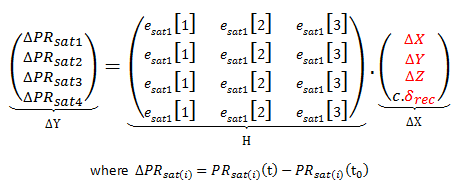PART41 » History » Version 7
« Previous -
Version 7/35
(diff) -
Next » -
Current version
COLIN, Tony, 03/19/2016 06:32 PM
PART 4 : Position Estimation.¶
- Table of contents
- PART 4 : Position Estimation.
.......................
1 - Ephemeris.¶
.......¶
2 - Navigation computation.¶
a - Reminder about the impairments.¶
The following figure gives the impairments affecting the range in case of the GPS system as well as the correction process :
Figure 4.1 : Pseudo-range measurement extracted from [2]
b - Demonstration of the Pseudo-ranges with Least Square method.¶
Starting from the fact that can determine most of the elements within the pseudo-range measurement PR_sat(i) from the information provided by each satellite, we have the equation :

Equation 1
or put in another way,

Equation 2
Indeed 4 measurements are needed, providing 4 equations with 4 unknows which are the receiver coordinates and the clock bias of the receiver. As the equation is highly non-linear, it is important to proceed to a linearization such as the Taylor expansion :

Equation 3
Hence,

Equation 4
or in matrix equation form,

Equation 5
which can be expressed as :

Equation 6
with the Least Square solution :

Equation 7
Note that all unknowns are depicted in red color
References :
[1] K. Borre, D. M. Akos, N. Bertelsen, P. Rinder, S. H. Jensen, A software-defined GPS and GALILEO receiver
[2] Position Estimation Workshop, March 2016
